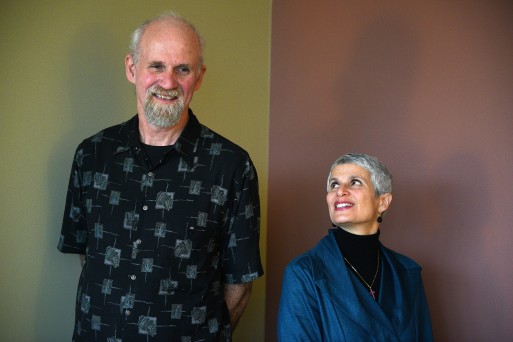 “Let’s Talk About Death: Asking The Questions That Profoundly Change The Way We Live and Die” is a powerful collection of frank, beautifully written email exchanges between Dartmouth professor Irene Kacandes and massage therapist and former journalist Steve Gordon exploring the topic of death. The fruitful correspondence between Kacandes and Gordon began on the one year anniversary of the murders of two of Kacandes’ friends, Susanne and Half Zantop, also Dartmouth professors.
“Let’s Talk About Death: Asking The Questions That Profoundly Change The Way We Live and Die” is a powerful collection of frank, beautifully written email exchanges between Dartmouth professor Irene Kacandes and massage therapist and former journalist Steve Gordon exploring the topic of death. The fruitful correspondence between Kacandes and Gordon began on the one year anniversary of the murders of two of Kacandes’ friends, Susanne and Half Zantop, also Dartmouth professors.
Kacandes and a group of friends of the Zantops decided to contact the editor of the region’s daily newspaper, the Valley News, to see if the paper would run a piece commemorating the lives of their friends — an attempt to shift the media focus around the murders from the perpetrators to a celebration of the Zantops’ lives. Steve Gordon was the editor of the Valley News at the time, and his kindness and the respect with which he treated the story made a deep impact on Kacandes.
Years later, Kacandes read in the same Valley News that Steve Gordon had made a career switch.
Years later, Kacandes read in the same Valley News that Steve Gordon had made a career switch. He had become a massage therapist and founded a non-profit called The Hand to Heart Project to offer free massages to cancer patients. Kacandes thought Gordon would be a good resource person for a couple of her students, and asked him if he’d be willing to be interviewed for a project. He agreed, and as a gesture of thanks she sent him a book and an article she’d written about the impact the Zantops’ murders had had on her life. Gordon made the connection immediately, and realized that Irene Kacandes, the Dartmouth professor, was the same Irene Kacandes who had contacted him years earlier about the commemorative article about the Zantops.
Then, in January 2011, nine years after the Valley News ran the original article, Kacandes reached out to Gordon in a state of distress over the murders — her grief triggered by the upcoming ten-year anniversary of their deaths. Steve responded by sending her set of CDs called “Being With The Dying” by Buddhist teacher Joan Halifax. Kacandes was deeply moved by Halifax’s message on suffering — that we can use it as a vessel for connection and as a road to cultivating more compassion.
Months later, Kacandes and Gordon met face to face, the topic of mortality at the forefront of their thoughts.
Months later, Kacandes and Gordon met face to face, the topic of mortality at the forefront of their thoughts. They discussed their shared urge to explore mortality through writing. Soon after, Kacandes left town to travel to New York and through Switzerland. During her travels, Kacandes and Gordon wrote to each other via email, the beginning of a lengthy correspondence in which they explore their ideas about and personal experiences with death and dying. That correspondence is what became “Let’s Talk About Death.”
The book details Kacandes’ and Gordon’s conversations as they pose questions to one another, probe each other and disagree about some fundamental issues such as that of personal agency. They support one another, share things they’ve read, and generally become more and more comfortable with the topic of mortality — a topic so many of us find so difficult to discuss.

Credit: vnnews.com
Kacandes’ first email to Gordon offers up a level of vulnerability that sets a tone for the rest of their correspondence. She talks openly and honestly about her struggles around her father’s declining health. In the four years of email exchanges collected in the book, Kacandes and Gordon talk about caregiving, medications, the right to die, the murders of the Zantops, common end-of-life fears, and finally, at the end of book, Kacandes’ own cancer diagnosis. The book reads, as Steve Gordon himself writes in one of the letters, “like a slowly unfolding conversation,” one I found alternately poignant, surprising, informative and touching. To be let into the intimate dialogue between these two lovely letter-writers is a real gift.
The book concludes with an appendix of resources to “help readers continue to develop their thinking on mortality.” It includes everything from Roland Barthes’ “Mourning Diary” (reflections on his own mother’s death) to books exploring the legal and ethical dilemmas of modern medicine to guidebooks for caregivers tending to the terminally ill.
This searching dialogue is a welcome addition to the literature on the topic of mortality — a topic we too often shy away from in our culture.

 ”Let’s Talk About Death” by Steve Gordon and Irene Kacandes
”Let’s Talk About Death” by Steve Gordon and Irene Kacandes


 Our Monthly Tip: Make an “In Case of Death” File to Ease Loved One’s Grief
Our Monthly Tip: Make an “In Case of Death” File to Ease Loved One’s Grief
 Passing of Beloved Comedian Births a New Comedy Festival
Passing of Beloved Comedian Births a New Comedy Festival















